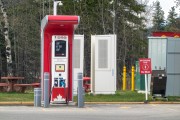Of the many challenges that fleet operators face in switching from fossil-fuelled commercial vehicles to electric ones, sufficient charging infrastructure is quite possibly the toughest one to overcome. Deploying enough stations, ensuring a reliable supply of power, expanding distribution networks, and providing the means for smaller operators to access chargers entails a high degree of collaboration among many players. Which is why we held the Getting Connected workshop at the Electric Autonomy conference in May of this year where representatives from industry, government, utilities and the non-profit sector prioritized the difficulties in building and accessing chargers and offered potential solutions.
The hurdles
The truism that taking a collaborative approach to a thorny issue is essential to problem solving was borne out by the panel discussions and feedback at the workshop. Here’s what we heard:
- If fleet owners and operators had to narrow the field down to the single largest roadblock standing in the way of more robust uptake of electric commercial vehicles, it would be the high cost of purchasing and installing charging equipment. The expenses associated with the construction of charging stations is out of reach for smaller operators — owners of as few as one or two delivery vehicles — whose businesses run on lean budgets and narrow profit margins. Even for bigger players, the expense of building out a charging network is daunting.
- Many expressed unfamiliarity with how electric medium- and heavy-duty vehicles (MHDVs) operate. Workshop participants noted widespread uncertainty about the average range of an electric delivery vehicle, its performance under adverse weather conditions, and how to refuel or recharge a zero-emission truck.
- Owners of smaller fleets raised concerns about insufficient public infrastructure. Because many such owners do not own a lot or depot, they are reliant on public chargers, which are still in short supply. Charging station operators explained that the business case for installing more public infrastructure to service zero-emission MHDVs is weak. It’s a vicious cycle: low uptake of electric road freight means that charging stations sit idle much of the time and fail to generate enough revenue to offset electricity input costs. Charging station operators are thus reluctant to invest in additional chargers. Fleet owners, lacking confidence that the charging network can meet an increase in energy demand, are hesitant to invest in decarbonizing their fleet.
- Aging electrical distribution systems are part of the problem. In many instances, those systems will require upgrading to handle the surge in energy flow from electric freight, yet utilities must adhere to regulatory obligations that require justifying upgrades based on historical usage rather than future scenarios.
The way forward
Finding ways to address the main impediments to building out charging infrastructure for electric MHDVs is not unlike navigating an obstacle course – tricky, but doable. Workshop participants offered four potential strategies to steer the sector in the right direction.
- Local utilities can make information about grid connection processes more readily available to fleet operators (including key contact people at local utilities, information on charger options, approval requirements, etc.).
- Governments can reduce regulatory complexities surrounding the construction of public chargers, and billing rates for energy usage should offer more favourable terms to charging station operators (given that, essentially, they buy in bulk) and structured to incentivize off-peak charging.
- Utilities and industry can increase access to data. Localized data, such as forecasts of projected growth in electric MHDVs and associated electricity demand, should be made available to utilities so that they can plan more accurately for grid expansion and upgrades. Similarly, distribution system planning should be re-visited so that forward-looking data and insights carry as much weight as historical energy usage patterns.
- Governments at all levels can establish funding pools, along with a variety of financial mechanisms, dedicated to supporting the installation of private charging stations for owners or operators of smaller fleets where feasible.
Insights from the insiders
At the Getting Connected workshop, senior managers with first-hand experience in overseeing their company’s transition to zero- and low-carbon fleets offered the following insights:
- Businesses based in B.C. or Quebec can take advantage of the advisory programs and guides offered by utilities and targeted to fleet owners. Some utilities even create heat maps showing where upgrading the grid is needed most urgently. To date, these resources are only available in two provinces, but all provinces should adopt the same practice.
- Change management is a big deal. Managers tasked with overseeing sustainability efforts should prioritize getting senior level management onboard. Organizational leaders may be unaware of what’s available on the market, the overall cost savings and other benefits from switching to electric, so need to be fully informed to make sound investment decisions. Once you get that buy-in, however, key decision makers are your greatest champions. A senior manager overseeing the fleet decarbonization at one of Canada’s largest delivery services noted the importance of bringing everyone along, from board members to frontline workers. This company’s transition to electric started over three years ago. Today, the board and senior executive support the transition, and drivers are fully committed to zero-emission trucks, saying that they didn’t want to drive anything else.
- "Don't take a ‘big bang’ approach to electrification. Instead, learn as you grow. Take your time," advised one industry representative. He noted that the company he worked for is the first to say that it isn't a first mover and is culturally risk averse. But the company also prides itself on being a fast follow and understands that fleet delivery services are moving into a new world. The best way to enter that world, advised this manager, is through a phased approach.
Here at the Pembina Institute
These and additional learnings from our workshop will be available in the Rethinking Regulations project report, to be released in Fall 2024. The project will identify a broad range of regulatory barriers to decarbonizing different sectors of Canada’s economy, including the transportation sector, with a particular focus on electric MHDVs and grid integration. Central themes that emerged from the workshop will also inform recommendations to Ontario’s electricity regulator and the Ontario government to advance the deployment of charging infrastructure.
We have also launched a new initiative to increase data access for utilities, municipalities and fleet operators. With the generous support of FedEx, we established the Grid Readiness project earlier this year. Designed to assist municipalities and utilities in the Greater Toronto and Hamilton Area, the project will map optimal locations for commercial freight charging and refuelling stations, and their anticipated energy loads. Insights from the Getting Connected workshop will also contribute to broadening the scope of the analysis in the Grid Readiness project by contributing perspectives from many stakeholders.





